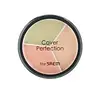What's inside
What's inside
 Key Ingredients
Key Ingredients

 Benefits
Benefits

 Concerns
Concerns

 Ingredients Side-by-side
Ingredients Side-by-side

CI 77891
Cosmetic ColorantCaprylic/Capric Triglyceride
MaskingPolyisobutene
Mica
Cosmetic ColorantIsodecyl Neopentanoate
EmollientDiisostearyl Malate
EmollientHydrogenated Castor Oil
EmollientDipentaerythrityl Hexahydroxystearate/Hexastearate/Hexarosinate
Skin ConditioningMethyl Methacrylate Crosspolymer
Butyloctyl Salicylate
Skin ConditioningCI 77492
Cosmetic ColorantParaffin
PerfumingAluminum Hydroxide
Emollient1,2-Hexanediol
Skin ConditioningSorbitan Sesquioleate
EmulsifyingMicrocrystalline Wax
Emulsion StabilisingCI 77491
Cosmetic ColorantMethicone
EmollientCI 77499
Cosmetic ColorantCaprylyl Glycol
EmollientSqualane
EmollientParfum
MaskingPrunus Amygdalus Dulcis Oil
Skin ConditioningWater
Skin ConditioningBHT
AntioxidantButylene Glycol
HumectantAspalathus Linearis Leaf Extract
Skin ConditioningThymus Vulgaris Extract
PerfumingFoeniculum Vulgare Leaf Extract
HumectantLinalool
PerfumingLimonene
PerfumingHexyl Cinnamal
PerfumingTitanium Dioxide
Cosmetic ColorantCI 77288
Cosmetic ColorantAlpha-Isomethyl Ionone
PerfumingCI 77891, Caprylic/Capric Triglyceride, Polyisobutene, Mica, Isodecyl Neopentanoate, Diisostearyl Malate, Hydrogenated Castor Oil, Dipentaerythrityl Hexahydroxystearate/Hexastearate/Hexarosinate, Methyl Methacrylate Crosspolymer, Butyloctyl Salicylate, CI 77492, Paraffin, Aluminum Hydroxide, 1,2-Hexanediol, Sorbitan Sesquioleate, Microcrystalline Wax, CI 77491, Methicone, CI 77499, Caprylyl Glycol, Squalane, Parfum, Prunus Amygdalus Dulcis Oil, Water, BHT, Butylene Glycol, Aspalathus Linearis Leaf Extract, Thymus Vulgaris Extract, Foeniculum Vulgare Leaf Extract, Linalool, Limonene, Hexyl Cinnamal, Titanium Dioxide, CI 77288, Alpha-Isomethyl Ionone
Silica
AbrasiveSimmondsia Chinensis Seed Oil
EmollientGlycerin
HumectantButylene Glycol
HumectantHelianthus Annuus Seed Oil Unsaponifiables
EmollientSqualane
Emollient1,2-Hexanediol
Skin ConditioningBrassica Oleracea Gemmifera Extract
AstringentSolanum Lycopersicum Fruit Extract
AntioxidantLecithin
EmollientSimmondsia Chinensis Leaf Extract
HumectantLeontopodium Alpinum Extract
Skin ConditioningHydrogenated Lecithin
EmulsifyingPhoenix Dactylifera Seed
Skin ConditioningAscorbic Acid
AntioxidantTromethamine
BufferingDipotassium Glycyrrhizate
HumectantCeramide NP
Skin ConditioningSodium Metabisulfite
AntioxidantSodium Sulfite
PreservativeSilica, Simmondsia Chinensis Seed Oil, Glycerin, Butylene Glycol, Helianthus Annuus Seed Oil Unsaponifiables, Squalane, 1,2-Hexanediol, Brassica Oleracea Gemmifera Extract, Solanum Lycopersicum Fruit Extract, Lecithin, Simmondsia Chinensis Leaf Extract, Leontopodium Alpinum Extract, Hydrogenated Lecithin, Phoenix Dactylifera Seed, Ascorbic Acid, Tromethamine, Dipotassium Glycyrrhizate, Ceramide NP, Sodium Metabisulfite, Sodium Sulfite
 Reviews
Reviews

Ingredients Explained
These ingredients are found in both products.
Ingredients higher up in an ingredient list are typically present in a larger amount.
1,2-Hexanediol is a synthetic liquid and another multi-functional powerhouse.
It is a:
- Humectant, drawing moisture into the skin
- Emollient, helping to soften skin
- Solvent, dispersing and stabilizing formulas
- Preservative booster, enhancing the antimicrobial activity of other preservatives
Butylene Glycol (or BG) is used within cosmetic products for a few different reasons:
Overall, Butylene Glycol is a safe and well-rounded ingredient that works well with other ingredients.
Though this ingredient works well with most skin types, some people with sensitive skin may experience a reaction such as allergic rashes, closed comedones, or itchiness.
Learn more about Butylene GlycolSqualane is an emollient that helps the skin hold onto moisture. It's an oily liquid that occurs naturally in certain types of fish and plant oils.
Because squalane boosts hydration in the skin, it also comes with plenty of benefits: it is an antioxidant and can help fight free radicals and skin damage. Squalane is also found to have a detoxifying effect when applied.
Squalane comes from squalene, which occurs naturally within the sebum of our skin. It is one of the oils our skin produces to keep itself hydrated. Squalane is the hydrogenated version of squalene and has a longer shelf life.
Research shows that squalane is non-irritating (even at 100% concentration).
In general, it's a fantastic ingredient. It does a great job at hydrating the skin, and it's suitable for those with sensitive skin.
The source of squalane may impact malassezia / fungal acne. This is because olive oil derived squalane can contain impurities such as fatty acids and plant waxes. Sugarcane derived squalane is recommended for anyone with malassezia concerns.
Is squalane vegan?
This depends on the source. Squalane can be derived from both plants and animals. Most squalane used in skincare comes from plants.
Please note: the source of squalane is only known if disclosed by the brand. We recommend reaching out to the brand if you have any questions about their squalane.
Read more about squalene with an "e".
Is squalane an oil?
Squalane is often called an oil, but it’s technically not; it’s a hydrocarbon, meaning it’s only made of carbon and hydrogen, unlike true oils which are triglycerides made of fatty acids and glycerol.
The term “oil-free” isn’t regulated, so companies can define it however they want. Some exclude all oils, while others just avoid mineral oil or comedogenic oils.
While some people avoid oils thinking they cause breakouts, the right kind of oil (or oil-like ingredient like squalane) can actually help balance and hydrate your skin. It’s worth testing out simple oils or squalane to see what works best for your skin.
Learn more about Squalane